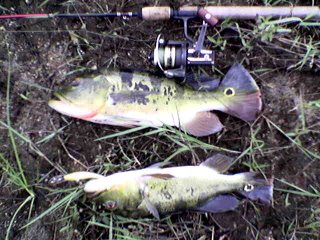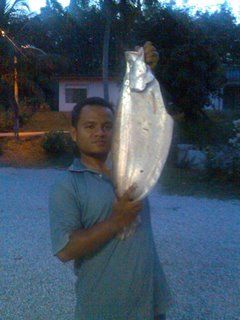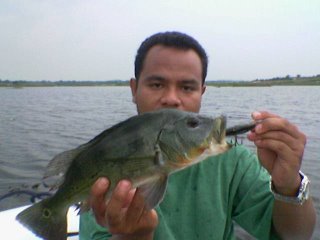Many consider this fish to be the toughest fighting fish in the world! It is extremely aggressive and acrobatic when hooked. Despite its name, the infamous Peacock Bass is the largest member of the cichlid family in Lake Guri. In some ways it does resemble a largemouth bass, but the larger Peacocks do not develop a pot belly and, during mating season, the males develop a large bump behind the head. In Portuguese and along most of the Amazon, the fish is called tucunaré. Due to the spot at the base of the tail, the Spanish nickname is pavon meaning peacock. In contradiction to North American bass, the larger the Peacock Bass, the better it fights. Be prepared for broken and lost tackle! The Peacock Bass, or Peacock Cichlid, is a native of South America including the Orinoco, Negro and Amazon river basins i.e. Venezuela, Colombia and Brazil. Regarded as a highly sought after and hard-fighting game fish, the species has been deliberately introduced into a number of waters in Singapore and West Malaysia by irresponsible anglers. Predatory in nature, and likely to feed on smaller native fish species, the long term survival of Peacock Bass will likely have a negative impact on the aquatic ecology of its adopted home.
The species is easily identified by the dark vertical bars on the flanks, and the peacock 'eye' on the tail fin of adults.
You can expect to catch Peacock Bass from 5 to 20 pounds in Guri. The unofficial known world record is close to 30 pounds. It is common that the Peacock Bass breaks 40 to 60 pound test lines. Their ferocious strikes and acrobatic jumps amaze any veteran angler and spoil him forever.
Peacock bass have elongate bodies with a deeply notched dorsal fin. Their mouth is large, the lower jaw projects beyond the upper jaw. They have a characteristic large black spot encircled by a silver colored halo on their caudal fin. Their coloration is olive-green dorsally fading to yellow-white ventrally, with three dark bars on their sides, between which are a series of dark spots. The first dorsal, upper caudal, and pectoral fins are gray or black, the anal, pelvics and the lower caudal fins are red. White spots are present on the second dorsal and the upper lobe of the caudal fin. Large adults have a yellow-orange stripe which extends from their mouth to their caudal fin.
Peacock bass are one of the big attractions to the lake, as 3 different pure strain varieties - speckled, butterfly and royal, are present in Guri waters. The Royal Peacock are the most abundant and also the largest, averaging 10 pounds or more and often reaching double digit weights. Most anglers hook over a dozen peacocks per day when conditions are right, usually boating one or more fish in the 12-20 pound class during their trips. Still, lunkers exceeding the 20-pound mark are caught every season, so it is no wonder that so many world records have been set and broken in the lake or it's head waters. With Peacocks, by the way, double headers are very common, and since these fish readily accept most offerings, they always provide spectacular action for spin, plug and fly casters alike.
Peacock bass are also notorious for following to the boat. It’s a bit like dealing with a following pike or muskie — you work your bait in a figure-eight pattern at boatside, with only a few inches of line off your rod tip. When one of them hits the lure though, the strike is nothing short of explosive. It just about rips the rod out of your hands, and it happens more often than not.
It seems that Peacock Bass travel in pairs or small packs, and are constantly on the move, feeding. You‘ll get into an area that’s really hot for a while, and then the fish move off and the action slows. So you do spend a bit of time looking for fish. Once you find them though, the fun begins.

 I normally catch them on lives prawn with small running sinker and circle hook at late afternoon and night.What i know is, they are a very shy species.Spotted belida at Timah Tasoh, perlis do take lure from spinnerbaits, soft plastic to deep divers. As far as i can recalled, featherbacks have been landed with grubs, sure catch softplastic, rapala rattling (blue/silver), deep diver form surecatch and i've caught it with Australian made deep diver called Predatek Boomerang (pink). They do take lures and not easy to get a solid hook up due to their bony mouth...
I normally catch them on lives prawn with small running sinker and circle hook at late afternoon and night.What i know is, they are a very shy species.Spotted belida at Timah Tasoh, perlis do take lure from spinnerbaits, soft plastic to deep divers. As far as i can recalled, featherbacks have been landed with grubs, sure catch softplastic, rapala rattling (blue/silver), deep diver form surecatch and i've caught it with Australian made deep diver called Predatek Boomerang (pink). They do take lures and not easy to get a solid hook up due to their bony mouth...




